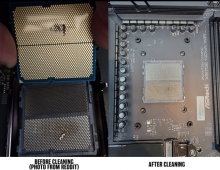
AMD Ryzen Processors Detailed; They Are Smart And Powerful
Today at its fan-focused event, AMD unveiled new information and gave enthusiasts hands-on time with its upcoming high-performance desktop processors based on the "Zen" core architecture (codenamed "Summit Ridge") in advance of the official launch in Q1 2017.
AMD introduced Ryzen, the brand which will span across "Zen"-based desktop and notebook processor families. Additionally, AMD introduced SenseMI, a set of sensing, adapting, and learning technologies built into the AMD Ryzen processor that combine with multiple other advances in architectural, platform, efficiency, and processing technology to address the demanding needs of gamers and enthusiast PC users.
AMD SenseMI technology is a key enabler of AMD's increase of greater than 40 percent in instructions per clock, and is comprised of five components:
- Pure Power - more than 100 embedded sensors with accuracy to the millivolt, milliwatt, and single degree level of temperature enable optimal voltage, clock frequency, and operating mode with minimal energy consumption

A number of recent microprocessor launches have revolved around silicon-optimized power profiles. Using distributed embedded sensors in the design that monitor temperature, speed and voltage, and the control center can manage the power consumption in real time.
The upshot of Pure Power is that the DVFS curve is lower and more optimized for a given piece of silicon than a generic DVFS curve, which results in giving lower power at various/all levels of performance.
- Precision Boost - smart logic that monitors integrated sensors and optimizes clock speeds, in increments as small as 25MHz, at up to a thousand times a second

With Precision Boost for Ryzen, AMD is increasing the DVFS curve to better performance due to Pure Power, but also offering frequency jumps in 25 MHz steps.
Precision Boost allows for adjustments of core frequency based on performance requirements and suitability/power given the rest of the core.
- Extended Frequency Range (XFR) - when the system senses added cooling capability, XFR raises the Precision Boost frequency to enhance performance

The current processors on the market have rated speeds on the box which are fixed frequency settings that can be chosen by the processor/OS depending on what level of performance is possible/required. AMD’s new XFR mode seems to do away with this, offering what sounds like an unlimited bound on performance.
The concept here is that, beyond the rated turbo mode, if there is sufficient cooling then the CPU will continue to increase the clock speed and voltage until a cooling limit is reached.
AMD states that XFR is a fully automated system with no user intervention.
- Neural Net Prediction - an artificial intelligence neural network that learns to predict what future pathway an application will take based on past runs

- Smart Prefetch - learning algorithms that track software behavior to anticipate the needs of an application and prepare the data in advance.

The "New Horizon" fan event showcased 8-core, 16-thread AMD Ryzen desktop processors running at 3.4 GHz in a number of hands-on demos of extreme performance and new features including:
- For the first time, the upcoming Vega GPU architecture was demonstrated live to fans, powered by Ryzen playing Star Wars Battlefront - Rogue One at 4K resolution with high framerates.
- Blender- and Handbrake-based image rendering and video transcoding demos showed that the new CPU can match or outperform the Intel Core i7 6900K -- also an 8-core, 16-thread processor -- in many complex creative tasks. The 140-watt TDP Core i7 6900K ran at stock processor speed and boost against a 95-watt TDP Ryzen processor at 3.4 GHz without boost, showing the computing power and performance-per-watt efficiency of Ryzen.
- Again at 3.4 GHz, Ryzen was shown beating the game framerates of a Core i7 6900K playing Battlefield 1 at 4K resolution, with each CPU paired to an Nvidia Titan X GPU.
There will be several SKUs in the brand, although AMD is not releasing many details aside from the cache arrangement of the 8-core, thread chip (which we already knew was 4MB of L2 + [8+8] MB of L3 victim-cache), and that the base clock for the high-end SKU will be at least 3.4+ GHz.

Ryzen will use the AM4 platform, shared with the previous generation Bristol Ridge which remains an OEM-only product for now. AM4 will use a split IO design between the CPU and the chipset such that for minimal function, a chipset is not needed, however AMD has pointed out that with Ryzen, AM4 with the right chipset will support USB 3.1 Gen 2 (10 Gbps), NVMe SSDs, SATA-Express, and offer 'ultimate upgradability'. The latter point may give an indication to the Ryzen based chipsets might offer numerous PCIe lanes, similar to what Intel does on the 100-series.

AMD Ryzen processors for desktops are expected to be available beginning in Q1 2017 and AMD Ryzen notebook processors are planned to launch in 2H 2017.





















